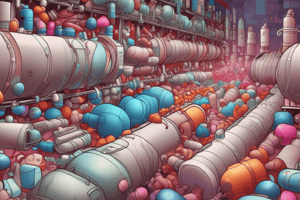Podcast
Questions and Answers
What is the primary mechanism of action of macrolides?
What is the primary mechanism of action of macrolides?
- Inhibit DNA synthesis
- Bind to 50S ribosomal subunits (correct)
- Inhibit folic acid synthesis
- Inhibit cell wall synthesis
Which of the following statements about the pharmacokinetics of erythromycin is true?
Which of the following statements about the pharmacokinetics of erythromycin is true?
- It is primarily excreted unchanged in urine.
- It is poorly absorbed when taken orally. (correct)
- Erythromycin does not pass the placental barrier.
- Erythromycin is not affected by gastric acidity.
Which of the following is NOT indicated for treatment with macrolides?
Which of the following is NOT indicated for treatment with macrolides?
- Chlamydia infections
- Respiratory tract infections
- Hypothyroidism (correct)
- Acne vulgaris
Which of the following is a known adverse effect of erythromycin?
Which of the following is a known adverse effect of erythromycin?
Macrolides are generally effective against which type of bacteria?
Macrolides are generally effective against which type of bacteria?
Which drug is specifically mentioned as having less gut upset compared to erythromycin?
Which drug is specifically mentioned as having less gut upset compared to erythromycin?
What is the significance of macrolides being more active in alkaline medium?
What is the significance of macrolides being more active in alkaline medium?
Which macrolide is utilized as a prokinetic agent in diabetic gastroparesis?
Which macrolide is utilized as a prokinetic agent in diabetic gastroparesis?
What is the mechanism of action of tetracyclines?
What is the mechanism of action of tetracyclines?
Which tetracycline is completely absorbed orally and not affected by food?
Which tetracycline is completely absorbed orally and not affected by food?
What adverse effect is associated with chloramphenicol in newborns?
What adverse effect is associated with chloramphenicol in newborns?
What significant effect do tetracyclines have on bone and teeth?
What significant effect do tetracyclines have on bone and teeth?
Which of the following tetracyclines is effective in the treatment of urinary tract infections due to its renal excretion?
Which of the following tetracyclines is effective in the treatment of urinary tract infections due to its renal excretion?
What is the primary reason tetracyclines are not commonly used despite having a broad spectrum?
What is the primary reason tetracyclines are not commonly used despite having a broad spectrum?
How do tetracyclines affect drug clearance when administered with antacids or dairy products?
How do tetracyclines affect drug clearance when administered with antacids or dairy products?
What precaution should be taken when administering tetracyclines to breastfeeding individuals?
What precaution should be taken when administering tetracyclines to breastfeeding individuals?
What is the mechanism of action for Clindamycin and Lincomycin?
What is the mechanism of action for Clindamycin and Lincomycin?
Which of the following statements regarding the pharmacokinetics of Clindamycin is true?
Which of the following statements regarding the pharmacokinetics of Clindamycin is true?
What is one of the primary clinical indications for Chloramphenicol?
What is one of the primary clinical indications for Chloramphenicol?
Which adverse effect is associated with Chloramphenicol?
Which adverse effect is associated with Chloramphenicol?
What is the spectrum of activity for Clindamycin?
What is the spectrum of activity for Clindamycin?
Which of the following is NOT a common indication for the use of Clindamycin?
Which of the following is NOT a common indication for the use of Clindamycin?
What is the main adverse effect of Clindamycin that could lead to serious complications?
What is the main adverse effect of Clindamycin that could lead to serious complications?
What type of infections is Chloramphenicol primarily effective against?
What type of infections is Chloramphenicol primarily effective against?
Which of the following antibiotics acts as an HME inhibitor, similar to erythromycin and clarithromycin?
Which of the following antibiotics acts as an HME inhibitor, similar to erythromycin and clarithromycin?
Flashcards
Tetracycline Absorption
Tetracycline Absorption
Tetracyclines' oral absorption is variable, with some forms absorbed less in the presence of food. Doxycycline, though, is fully absorbed irrespective of food.
Tetracycline Chelation
Tetracycline Chelation
Tetracyclines bind to metal ions like calcium, aluminum, magnesium, and iron, reducing their absorption.
Tetracycline Distribution
Tetracycline Distribution
Tetracyclines have poor penetration into the brain, except for Minocycline, which can reach sufficient cerebrospinal fluid (CSF) levels. They cross the placenta and are teratogenic (harmful to a fetus).
Tetracycline Excretion
Tetracycline Excretion
Signup and view all the flashcards
Tetracycline Mechanism
Tetracycline Mechanism
Signup and view all the flashcards
Gray Baby Syndrome
Gray Baby Syndrome
Signup and view all the flashcards
Tetracycline Use in UTIs
Tetracycline Use in UTIs
Signup and view all the flashcards
Doxycycline in Renal Impairment
Doxycycline in Renal Impairment
Signup and view all the flashcards
Clindamycin/Lincomycin - Spectrum
Clindamycin/Lincomycin - Spectrum
Signup and view all the flashcards
Clindamycin/Lincomycin - Pharmacokinetics
Clindamycin/Lincomycin - Pharmacokinetics
Signup and view all the flashcards
Clindamycin/Lincomycin - Indications
Clindamycin/Lincomycin - Indications
Signup and view all the flashcards
Clindamycin/Lincomycin - Adverse Effects
Clindamycin/Lincomycin - Adverse Effects
Signup and view all the flashcards
Chloramphenicol - Mechanism of Action
Chloramphenicol - Mechanism of Action
Signup and view all the flashcards
Chloramphenicol - Spectrum
Chloramphenicol - Spectrum
Signup and view all the flashcards
Chloramphenicol - Pharmacokinetics
Chloramphenicol - Pharmacokinetics
Signup and view all the flashcards
Chloramphenicol - Indications
Chloramphenicol - Indications
Signup and view all the flashcards
Macrolide Mechanism
Macrolide Mechanism
Signup and view all the flashcards
Macrolide Spectrum
Macrolide Spectrum
Signup and view all the flashcards
Erythromycin's Acid Sensitivity
Erythromycin's Acid Sensitivity
Signup and view all the flashcards
Clarithromycin's Advantages
Clarithromycin's Advantages
Signup and view all the flashcards
Azithromycin's Unique Feature
Azithromycin's Unique Feature
Signup and view all the flashcards
Macrolides and CYP450
Macrolides and CYP450
Signup and view all the flashcards
Macrolide Uses
Macrolide Uses
Signup and view all the flashcards
Ketolides
Ketolides
Signup and view all the flashcards
Study Notes
Macrolides
- Types: Erythromycin, clarithromycin, azithromycin, Roxithromycin, Olendamycin, Spiramycin
- Erythromycin Source: Natural
- Absorption: Absorbed orally but destroyed by stomach acid, given enteric-coated. IV administration is also possible.
- Blood-Brain Barrier (BBB) Penetration: Poor penetration
- Placental Barrier: Crosses the placental barrier, safe for use in pregnancy
- Metabolism: Metabolized in the liver
- Excretion: Excreted in urine and bile
- Mechanism of Action: Binds reversibly to 50S ribosomal subunits, inhibiting protein synthesis translocation. More active in alkaline environments.
- Bactericidal/Bacteriostatic Action: Bacteriostatic or bactericidal, depending on concentration
- Spectrum: Effective against Gram-positive cocci and bacilli, some Gram-negative cocci and bacilli (e.g., H. influenza)
Clarithromycin
- Compared to Erythromycin: More active against atypical bacteria, better oral absorption, less stomach upset
- Uses: Peptic ulcer treatment (eradicate H. pylori)
- Mechanism of Action (similar to erythromycin)
Azithromycin
- Compared to Erythromycin: More active against mycobacteria and Chlamydia, less active against Staphylococcus and Streptococcus
- Tissue Concentration: High tissue concentration; slow release from tissues
- Administration: Given once daily
- Mechanism of Action (similar to erythromycin)
Ketolides (Telithromycin)
- Type: Semi-synthetic macrolide
- Administration: Given orally once daily, high tissue concentration
- Spectrum: Active against Gram-positive, Gram-negative bacteria, and Chlamydia
- Mechanism of Action (similar to erythromycin)
- Uses: Useful in cases of bacterial resistance to macrolides
Lincosamides (Clindamycin & Lincomycin)
- Absorption: Absorbed orally and intravenously (IV). High concentration in bone and teeth.
- Metabolism: Metabolized by the liver, excreted in urine and bile
- Mechanism of Action: Similar to macrolides
- Spectrum: Similar to macrolides, but more active against anaerobes, except Clostridium difficile
- Indications: Treatment of anaerobic infections, prophylaxis against endocarditis, treatment of intra-abdominal/female genital infections
- Adverse Effects: Superinfection by Clostridium difficile (pseudomembranous colitis), gastrointestinal disturbances, liver dysfunction
Broad-Spectrum Antibiotics: Chloramphenicol
- Source: Natural
- Absorption: Well absorbed orally, inject or topical. Passes BBB.
- Metabolism: Metabolized by liver. Excreted primarily in urine.
- Mechanism of Action: Binds to 50S ribosomal subunit, inhibits peptidyl transferase leading to protein synthesis inhibition.
- Spectrum: Effective against Gram-positive, Gram-negative bacteria, rickettsia, and anaerobes.
- Indications: Respiratory tract infections, typhoid fever, meningitis, rickettsial infections, anaerobic infections and topical use (eye/ear).
- Adverse Effects: Bone marrow depression (e.g., agranulocytosis).
Tetracyclines
- Source: Natural and semi-synthetic
- Absorption: Variable, many are incompletely absorbed with food. Doxycycline unaffected by food.
- Chelation: Forms complexes with divalent cations (Ca2+, Mg2+, Al3+), reduces absorption.
- Distribution: Poor penetration of BBB, except minocycline. High bone, tooth, and calcified tissue concentration.
- Excretion: Primarily excreted via urine.
- Mechanism of Action: Binds 30S ribosomal subunit, inhibits protein synthesis
- Spectrum: Broad spectrum; gram positives and negatives, chlamydia, rickettsia, spirochetes, and amoeba (luminal)
- Indications: Variety of infections (respiratory, urinary, GI, other)
- Adverse Effects:
- Toxic effects
- Gastrointestinal disturbances
- Superinfections
- Caries
- Photosensitivity
- Teratogenicity
- Other toxicities (hepatotoxicity,Fanconi syndrome,nephrotoxicity, CNS disturbances);
Studying That Suits You
Use AI to generate personalized quizzes and flashcards to suit your learning preferences.




